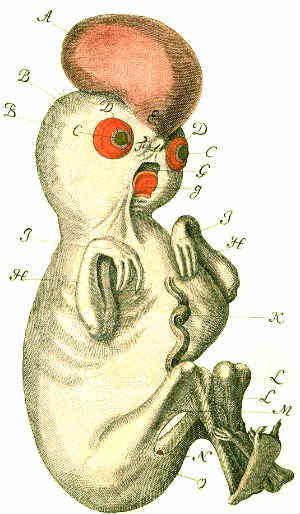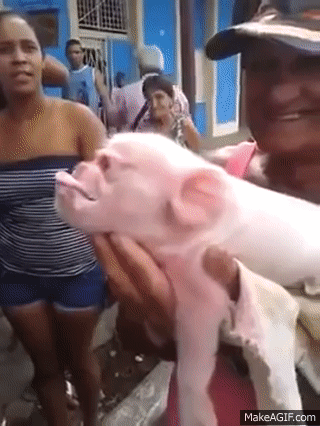Human-chicken Hybrids
Page 1: The Hühnermensch
EUGENE M. MCCARTHY, PHD GENETICS, ΦΒΚ
|
If a woman gives birth to a child with a bird’s head, the land will be destroyed.
—A Mesopotamian birth omen‡
|
Note: The report quoted below, which was written by a physician, states that a woman gave birth to a "child" with many of the characteristics of a chicken. With the exception of the news report quoted at right (source), all other reports about human-chicken hybrids seem to refer to offspring hatched from eggs laid by chickens.
 The Hühnermensch (as depicted in Friderici 1737). (Enlarge) The original engraving is life-sized (crown-rump length of subject is 20 cm). A: red-pigmented structure similar to the comb of a domestic fowl; B: sparse, downy hair; C: circular eye openings (as in G. gallus); D: red periophthalmic rings (as in G. gallus); E and F: nasal opening with rudimentary nares; G: oral cavity; g: external tongue (or wattle?); H: the “upper extremities are not unlike those of a plucked chicken”; I: hands with lengthy fingers and “claws exactly like those of a chicken”; K: umbilical cord; L: “The deformed feet, which are in an abnormal position and attached to chicken-like shanks, are, with the exception of their soles, of a wholly unwonted form, with the toes marvelously distorted and tipped with claws that are likewise exactly those of a domestic chicken”; M: cutaneous flap joining the thighs with the calves; N: a red-pigmented lentiform structure in place of normal human genitalia; O: anus (cloaca?).
The Hühnermensch (as depicted in Friderici 1737). (Enlarge) The original engraving is life-sized (crown-rump length of subject is 20 cm). A: red-pigmented structure similar to the comb of a domestic fowl; B: sparse, downy hair; C: circular eye openings (as in G. gallus); D: red periophthalmic rings (as in G. gallus); E and F: nasal opening with rudimentary nares; G: oral cavity; g: external tongue (or wattle?); H: the “upper extremities are not unlike those of a plucked chicken”; I: hands with lengthy fingers and “claws exactly like those of a chicken”; K: umbilical cord; L: “The deformed feet, which are in an abnormal position and attached to chicken-like shanks, are, with the exception of their soles, of a wholly unwonted form, with the toes marvelously distorted and tipped with claws that are likewise exactly those of a domestic chicken”; M: cutaneous flap joining the thighs with the calves; N: a red-pigmented lentiform structure in place of normal human genitalia; O: anus (cloaca?).
Although some may take lurid interest in gazing at pictures of deformed infants such as those shown on this page, this article was written for a different reason, that being to record information that will assist scientists in answering a single question: How different can two animals be if they are to produce a hybrid together? Of course, this question cannot be answered by simply reading this page. After all, the creature discussed here may not even be a hybrid (though genetic tests of the specimen, which is still available, would probably be able to resolve that issue). But the information documented here will help anyone who wishes to investigate the matter further.
In 1735, the German physician Gottlieb Friderici (1693-1742) attended the delivery of an infant in the small town of Taucha, a few kilometers northeast of Leipzig. His patient, 28-year-old Johanna Sophia Schmied, had previously given birth to three normal boys, and Friderici anticipated nothing unusual.
“But then,” he writes,
Friderici’s “dreadful monster,” stillborn that day after an eight-month gestation, was indeed peculiar, so peculiar that he took the trouble to write up a detailed anatomical account, entitled Monstrum humanum rarissimum (i.e., An Exceedingly Rare Human Monster), which he published two years later (Friderici 1737). He also immediately hired an artist to prepare engravings of this strange birth, now known as the Hühnermensch (“chicken-human”). The resulting illustrations, reproduced here, accompanied Friderici’s account.
This remarkable specimen has been preserved in the collection of the Heimatmuseum und Naturalienkabinett Waldenburg, a museum in Saxony, and is therefore available for genetic testing. Either by coincidence or by heredity, it does seem to have enough characteristics in common with chickens to earn its name. Friderici repeatedly commented on the ostensible connection this babe makes between Class Mammalia and Class Aves. For example, during the course of his anatomical description, he says,
“The deformed feet,” he says,
As do chickens, this literal Wunderkind has eye rings (periophthalmic rings) and a comb-like structure atop its head, both composed of red tissue, as in chickens. In addition, as in all birds, the ears are represented by only a small opening with no raised, external ears (pinnae), which are present in all mammals other than monotremes. Also as in birds, external genitalia are absent and the testes are internal.
|
Article continues below
|
 The director of Moscow’s Natural History Museum, Johann Gotthelf Fischer von Waldheim, described a living human-chicken hybrid kept at the museum.
The director of Moscow’s Natural History Museum, Johann Gotthelf Fischer von Waldheim, described a living human-chicken hybrid kept at the museum.More information >>
It can also be seen in the illustrations that the skin is loosely attached to the underlying tissues, so loosely that it forms webbing at various regions of flexure (neck, elbow, knee, crotch). The skin of a bird, too, is more elastic and more loosely attached to the body than is that of the typical mammal, which is generally interpreted as giving birds the freedom of movement needed for flight (Stettenheim 2000).
The heart, too, was larger than that of an ordinary human infant. And, according to a Kentucky University webpage on the avian circulatory system,
During the necropsy, Friderici found that the comb-like structure atop the head actually contained brain tissue, a situation reminiscent of that described by Purohit et al. (1977), who note that many hybrids produced by crossing pheasants with chickens are exencephalic (i.e., the brain is located outside the skull).
Among the anomalies exhibited by the Hühnermensch is a syndrome known as kleeblattschädel, a congenital anomaly in which there is intrauterine synostosis of multiple or all cranial sutures. This is another avian characteristic of the specimen, because in birds the cranial sutures also fuse at a very early stage of development (Brown 1915, p. 72).
If the Hühnermensch actually is a bird-mammal hybrid, then at this distance in time, one can only speculate about what might have happened back in Taucha all those many years ago. Did a rooster wander into a rustic bedroom and sit for a time on the lap of his naked mistress? Perhaps Johanna Sophia Schmied was a member of a coven that engaged in dark orgiastic rites that resulted in a weird creature seeing the light of day? Or possibly one day while gathering eggs she had her hands full and placed some rooster-semen-coated eggs in her underpants to carry them back to the house? Whatever happened, it seems the Hühnermensch took flight from there.
Some very strange pairings can result from imprinting. When a newborn mammal or bird is exposed to some animal not of its own kind it may “imprint” on that animal, that is, later in life it may seek mates of that kind rather than its own, as a sexual partners. In connection with the present case, Hess (1959) reports that he imprinted a rooster on human beings by exposing him only to humans during the first month of life and keeping him strictly away from other chickens. As an adult, the rooster sought only human mates even when allowed access to hens. And videos on YouTube (e.g., see videos at right above) show roosters interacting sexually with human body parts. So one can think of various scenarios based on this knowledge, for example, an accidentally imprinted rooster, an intoxicated or unconscious woman, and a very unusual mating.
At any rate, this specimen is a very interesting one and, given that it would no doubt be an F₁ hybrid (if it is a hybrid at all), it would be very easy to detect its origins with genetic testing. One quick and easy method would be PCR amplification using human and chicken primers. As Cicero once said (De Officiis, I, 6),
Two living human-chicken hybrids >>
More about human-chicken hybrids >>
By the same author: Handbook of Avian Hybrids of the World, Oxford University Press (2006).
